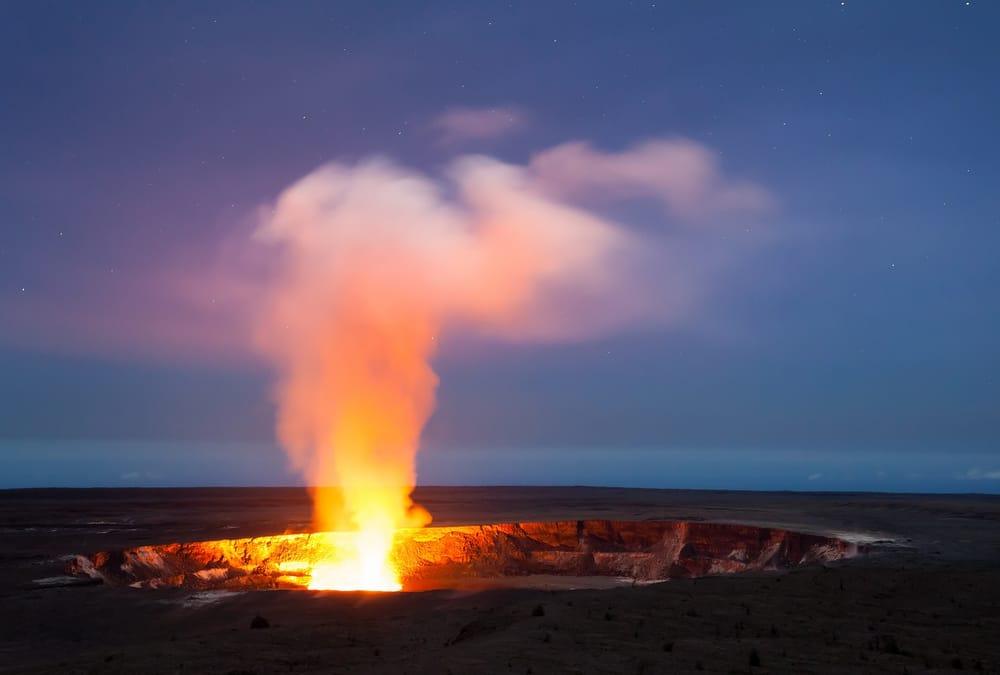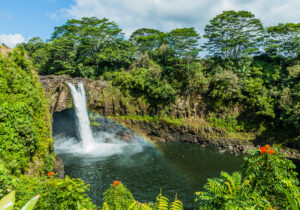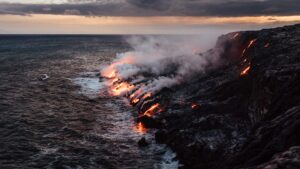Kilauea volcano in the Hawai’I Volcanoes National Park is a favorite stop on our volcano tours. Join us for a once-in-a-lifetime experience. Here is an article from The National Park Service on shield volcanoes.
Bering Land Bridge National Preserve, Crater Lake National Park, Craters Of The Moon National Monument & Preserve, El Malpais National Monument, Haleakalā National Park, Hawaiʻi Volcanoes National Park, Kalaupapa National Historical Park, Lassen Volcanic National Park, Lava Beds National Monument, National Park of American Samoa , Santa Monica Mountains National Recreation Area, Wrangell – St Elias National Park & Preserve, Yellowstone National Park
Introduction
Although shield volcanoes are the largest volcanoes on Earth, they do not form soaring mountains with conical peaks like composite volcanoes. Instead, they are broad volcanoes with gentle slopes and are shaped somewhat like a warrior’s shield lying flat on the Earth. Shield volcanoes have a convex shape as they are flatter near the summit.
Shield volcanoes are truly massive with volumes that dwarf other types of volcanoes, even large composite volcanoes.
Shield volcanoes are usually constructed almost entirely of basaltic and/or andesitic lava flows which were very fluid when erupted. They are built by repeated eruptions that occurred intermittently over vast periods of time (up to a million years or longer).
Shield volcanoes are much wider than they are tall. Mauna Loa’s base on the sea floor is about 100 miles (160 km) wide. Mount Rainier, the tallest composite volcano in the contiguous United States, is about 14,000 feet (4,270) tall, but only about 10 mi ( 16 km) wide. Overall, the bulk of shield volcanoes is substantially greater than that of composite volcanoes.
National Park Shield Volcanoes
At least 13 national parks contain shield volcanoes, including:
- Hawai’i Volcanoes National Park contains parts of Mauna Loa and Kīlauea, two of the most active shield volcanoes on Earth. Although these volcanoes are adjacent to one another, they have separate magma systems and are thus independent of one another.
- Mauna Loa is the largest active volcano on the planet. As measured from its base on the sea floor, the mountain is almost 33,500 feet (10,211 m) tall, with about 19,700 feet (6,000 m) of its total elevation below sea level. The summit of Mauna Loa is slightly lower in elevation than the nearby Mauna Kea volcano, but Mauna Loa has a much greater volume.
- Kīlauea volcano is one of the most active volcanoes on Earth. With the exception of a quiet period between 1924 and 1952, Kīlauea has been in eruption for most of the interval that there are reliable written records (e.g., since 1780 CE (Common Era)). Eruptions have occurred from both the rift zones and the summit caldera.
- Kaloko-Honokōhau National Historic Park is located on the flank of Hualālai, one of the five shield volcanoes that make up the island of Hawai‘i.
- Wrangell-St. Elias National Park in Alaska contains eight andesitic shield volcanoes, including Mount Wrangell which is the youngest. Mount Wrangell is considered active since it is reported to have experienced a short explosive eruption in 1930. Most of the older volcanoes in the park, including Capital Mountain, Tanada Peak, Mount Jarvis, and Mount Blackburn, have been eroded and no longer retain their shield shape, and some are poorly understood because of the extensive glaciation in this volcanic field.
- The Espenberg volcanic field in Bering Land Bridge National Monument (Alaska) contains five small shield volcanoes that formed during the Pleistocene.
- Lava Beds National Monument (California) is on the northern flank of Medicine Lake Volcano, a large shield volcano. The basaltic lava flows in the monument range in age from about 114,000 to 1,000 years old .
Overall Description
Shield volcanoes have very gentle slopes of only a few percent that become even more gentle near the summit. The great width of these volcanoes relative to their height is the result of the low viscosities of erupted lavas that produce thin widespread lava flows, eruptions from both the summit and fissure vents on the volcano’s flanks and widening and subsidence along the summit and rift zones. Lava flows may travel in channels or in lava tubes great distances from the vent where they were erupted.
Large shield volcanoes typically have calderas at their summits which may contain long-lasting lava lakes. Shield volcanoes may also have pit craters, which are smaller collapse structures, often with vertical sides.
Large shield volcanoes are polygenetic, meaning that they experience many eruptions during their lifetime.
Kīlauea’s Southwest Rift Zone and the East Rift Zone. More than 90% of Kīlauea’s surface is covered by lava flows that were erupted within the last 1,000 years.
Magma Composition
Shield volcanoes are usually basalt but can be constructed of mostly andesitic lava flows. Mauna Loa and Kīlauea erupt almost exclusively basaltic lavas. Shield volcanoes in Wrangell-St. Elias National Park, are made up of andesitic lava flows.
Eruption Types and Classification
Most shield volcano eruptions are nonexplosive (effusive), usually 0-1 on the Volcanic Explosivity Index (VEI), typically in the Hawaiʻian eruptive style. These eruptions produce fluid lava flows and may produce fire-fountains. High rates of eruptions help produce lava flows that travel fast and can cover large areas.
Rarely, more explosive phreatic or phreatomagmatic eruptions may occur. Powerful phreatomagmatic eruptions at Kīlauea have occurred at intervals during its history. One interval lasted until about 1000 CE and another from about 1500 to 1800 CE. Explosive eruptions also took place in 1924 in the Kīlauea caldera.
Occurrence
Shield volcanoes occur anywhere where there is basaltic (and sometimes andesitic) volcanism, including at oceanic hot spot tracks such as in the Hawaiʻian Islands. They may also be present at mid-ocean spreading ridges. They are present in a wide variety of continental environments, including adjacent to subduction zones, in continental rift zones, and in other intercontinental settings.
Geologic Features on Shield Volcanoes
Summit Calderas
Collapse calderas are usually located at the summit of large shield volcanoes. These calderas form via subsidence caused by removal of magma from the shallow magma chamber underneath the summit by eruption or intrusion, commonly on the flank of the volcano.
A shield volcano may have many summit calderas during its lifespan as they may become filled with lava. Summit calderas are dynamic as they may change due to further subsidence, have active lava lakes, and/or contain pit craters.
Lava Lakes
Lava lakes may form in some calderas or other vents on shield volcanoes when there is good connectivity between the vent and the magma supply. Mauna Loa and Kīlauea in Hawai’i Volcanoes National Park have both had persistent lava lakes in their calderas at various points during historical eruptions.
Rift (Fissure) Zones
Eruptions that occur along rift (fissure) zones are a major feature of some shield volcanoes, particularly the shield volcanoes that make up Hawai‘i. The presence of rift zones are responsible for these shield’s elongated shapes. Rift zones and summit vents typically share the same magmatic source with magma moving laterally from the shallow magma chamber beneath the summit to feed rift eruptions.
The rift zones on Mauna Loa and Kīlauea contain vents, fissures, pit craters, spatter cones, cinder cones, and grabens. Kīlauea’s rift zones are oriented parallel to the mobile southern flank that accommodates spreading and widening since Kīlauea is buttressed against Mauna Loa on its northern flank. Eruptions occur along rift zones because they are areas of weakness, hence allow pathways for magma to travel within the volcanoes.
Lava Flows
Shield volcanoes are constructed primarily of thin lava flows that cover large areas. Basaltic shield volcanoes such as Mauna Loa and Kīlauea in Hawai’i Volcanoes National Park erupt primarily pāhoehoe and ‘a‘ā lavas. Pāhoehoe lava flows have a smooth ropy surface and ‘a‘ā has a rough rubbly or fragmented surface crust.
Lava Tubes
Lava tubes form when molten lava flows in channels underneath a solidified crust of a lava flow. Empty tubes can be left when lava drains out when it is redirected or upon the end of an eruption.
In Hawai’i, lava tubes have great cultural importance. They provided shelter to Native Hawaiʻians, and were central in some ceremonies and burials.
Landslides
Landslides can play a significant role in shaping shield volcanoes. Landslides are a major part of the life cycles of the shield volcanoes in Hawai’i, including Mauna Loa and Kīlauea.
Volcanic Hazards
Vog (volcanic smog) consists of SO2 (sulfur dioxide) gas and aerosols produced by active shield volcanoes. It presents a hazard both in the immediate area and to people who are downwind.
Landslides along the flank of the volcano, subsidence at calderas and pit craters, and active fumaroles may also present volcanic hazards.





